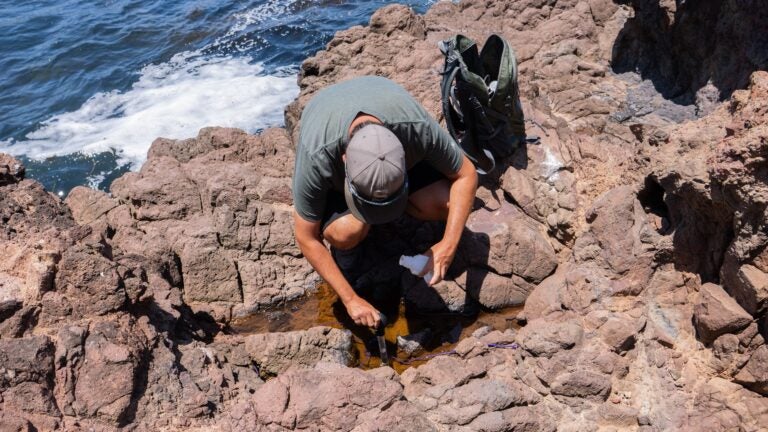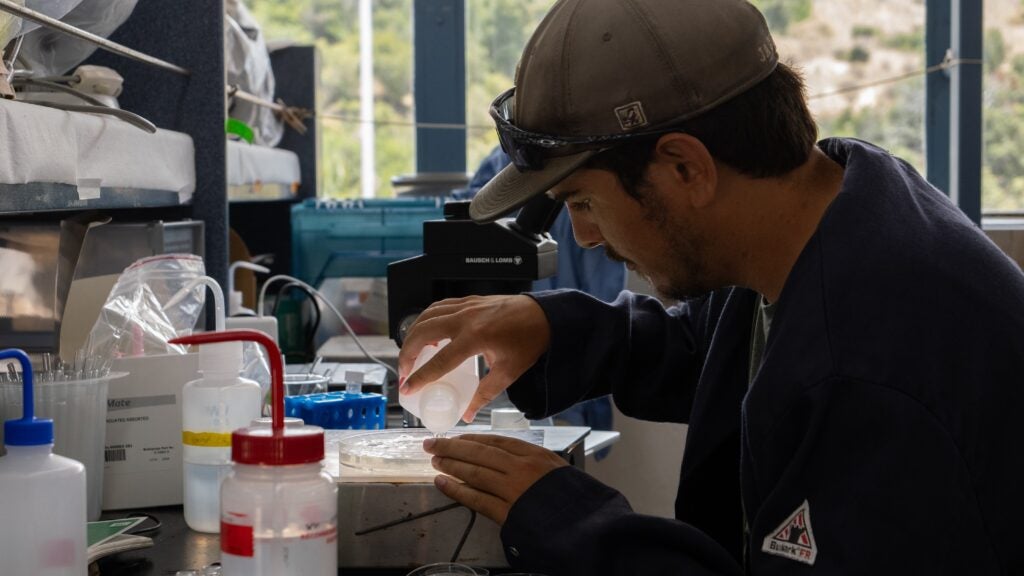
2024 Wrigley Institute Graduate Fellow Jacob Denova collects samples at tidepools found at the Wrigley Marine Science Center on Catalina Island (Alex Luce/USC Wrigley Institute)
Feelin’ hot hot hot… How zooplankton survive increasing temperatures
How do you test a question in an environment as large as the ocean? With so much variance in conditions and interactions that may occur, whittling down a hypothesis to a testable question can prove daunting. Testing every single combination of possibilities is impossible, so one strategy is to test the extremes of a question to see the clearest results. Understanding how organisms survive in extremely harsh conditions can shed light on mechanisms that may be similar across species so we can predict how untested organisms might react. For instance, Tigriopus californicus, a copepod species of zooplankton that lives in extremely dynamic conditions, can be used as a baseline to form hypotheses about other zooplankton.
Copepods are an extremely abundant and diverse class of zooplankton found across the planet. These very small, shrimp-looking invertabrates form much of the foundation of the food webs across marine environments. T. californicus reside in a unique tidepool environment above the high tide in an area aptly named the “splash-zone.” This area is special because it only gets covered by the ocean waters in the most extreme tides and in the roughest storms. Copepods that live here are otherwise at the mercy of runoff and splash from large waves to replenish the pools that form in this splash-zone.
These pools face harsh conditions imposed by the heat and light of the sun to create an extremely dynamic environment on daily to seasonal timescales. For instance, while open ocean temperatures around Wrigley Marine Science Center (WMSC) almost never exceed 75°F, the tidepools in the splash zone can exceed 100°F multiple times during the summer. Due to a lack of consistent water input, evaporation is also a constant threat during hot and dry months. As the water evaporates, it leaves behind salt, which can concentrate to over five times the salinity of normal seawater.
Oxygen levels in the water are also affected, with pools being oversaturated with oxygen during the day, and then becoming hypoxic (undersaturated) at night due to organisms consuming oxygen with no replenishment from mixing or photosynthesis. Despite all these hardships, T. californicus thrive in these dynamic tidepools, and the harsh conditions leave these ~ 1 mm-long zooplankton at the top of the food chain in this unique habitat. Since very few animals can survive in these extreme conditions for very long, scientists have many questions about how these animals continue to do so.

I became interested in T. californicus when I began looking for labs to work with for my PhD. My undergrad experiences had led me into a lab where I worked with fruit flies to investigate pathways involved in a body’s response to cancer. This lab got me interested in using small organisms to model bigger problems, but I found myself yearning for some field work to break up the monotony of staring down a microscope.
Further along in my undergrad career, I got the opportunity to work in a herpetology lab that fulfilled that desire. I tromped through Missouri wetlands catching bullfrogs and hiked on “Snake Road” to observe cottonmouth snakes. I decided I liked both the immense background knowledge offered by the use of a model organism, plus the opportunity to work in the field. I specifically chose to work with T. californicus because it allows me to do both.
The first two chapters of my dissertation are focused on T. californicus genetics and how mitochondria interact with the nucleus, while the work I’m doing now will help me explore how they survive in their natural habitat. My goal is to understand how T. californicus heat tolerance varies in response to environmental conditions. Prior research suggests periods of increased salinity may induce increased heat tolerance. Other work concludes that previous high heat events confer greater tolerance to subsequent ones.
Using copepods collected daily from WMSC, we aim to untangle this mystery, as well as include and expand on aspects that existing studies have not. For example, previous work has not tracked how sex plays a role in heat tolerance, despite evidence showing that T. californicus females are generally more tolerant to stress. Additionally, we plan to measure animals’ protein-to-lipid ratios to understand how these animals prepare for and survive intense periods of stress on an organismal level. Together, these tests will give a holistic picture showing how these animals’ dynamic environment affects how they survive it.
This fellowship has allowed me to explore the tidepools at WMSC to find local populations that live in this unique habitat. Being able to stay onsite has allowed me to pack all of my gear and samples to the tidepools and back every day for an extremely comprehensive set of data. Luckily, I haven’t had to go through this workload alone. I’ve had a ton of help from an undergraduate Zinsmeyer intern, Kathrina Welborn. She has been a great help through the entire process, particularly with her construction skills as we troubleshot experimental setups. Together we’ve been able to split field and lab responsibilities as well as develop questions and tests more specific to her interests, so she is able to develop skills relevant to what she hopes to do in graduate school.
I’m thankful for the opportunities this fellowship has allowed me to have, and I’m excited to see the results of our hard work this summer!
Jacob Denova is supported by the Victoria J. Bertics Graduate Fellowship Fund.